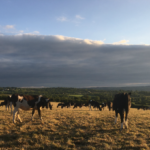
From the Frying Pan into the Fire
April 2018 was a tough month. Every week, we hoped that the rain would stop and each week, the weather forecasters dashed our hopes as fields remained waterlogged, grass grew slowly and livestock stayed indoors eating the last of the winter fodder. Many farmers, mostly those on drier land and accustomed to having their livestock out in February and March, ran out of fodder and had to purchase more.
The cows were indoors for months on end this winter. Every day of April was boring and repetitive, feeding cows, scraping and liming cubicles, trying to empty slurry tanks by a foot or so on a dry day, waiting for the weather to take up so we could get on with the spring jobs. Even when the rain stopped and the sun shone on the occasional day, the land was still too wet to withstand the weight of cows. On sunny mornings, the cows stopped and looked at me in disbelief as I directed them towards their cubicle shed, before they walked in unwillingly and begrudgingly. I didn’t know who to feel more sorry for – the cows or the farmers.
We were almost out of silage when the ground was eventually dry enough to let the cows out, having stretched supplies by purchasing beet pulp and extra dairy nuts for the cows. Normally, we’d have plenty of surplus silage left to carry from one year to the next, there in case of an extremely wet summer knowing we might need it at some stage.
Eventually the weather improved. May was a good month, temperatures rose, grass growth took off. Grass ‘shot out’ becoming stemmy. We had too much grass so made 180 silage bales from the surplus. Plenty of silage bales for the autumn we thought, perfect for buffering the cows when grass growth slows. We were literally making hay while the sun shone and building up fodder stocks. We harvested 120 acres of silage on 26th May and felt positive about building up enough fodder to withstand another long winter should the worst happen again. As we looked forward to the rest of the summer, the only slight concern was in case the weather became wet later in the summer. Good weather was forecast so we were optimistic for making plenty of silage for winter 2019.
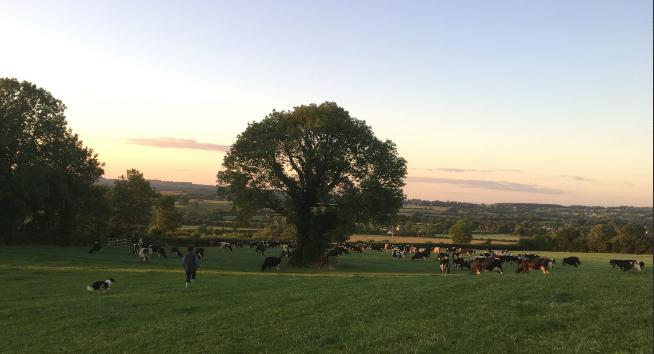
A summer’s evening
As we moved into June, temperatures rose further and the rain reduced and then disappeared. Aside from some rain last Sunday, we haven’t had any rain at all for weeks, some farms haven’t had any rain of note for six weeks. Many fields are so burnt, the grass is crispy. The Emerald Isle, normally so green, is in a drought situation with water restrictions at night and a hosepipe ban.
Water Shortages
We had one very hot week with temperatures into the 30s. As temperatures reduced somewhat, the rain still stayed at bay. Vegetable and flower farmers had to irrigate crops. Some farmers, those with a river running through their land, irrigated pasture fields. As river levels fell, they were stopped doing so. Private wells ran dry or reduced significantly in pressure. Some farmers bored for new wells. Some had to get water elsewhere to meet their needs.
Thankfully we have two wells. We put in new piping and extended the water supply from the better well so it now supplies most of the fields. On very hot days, we divided the cows into two groups so they went to two different fields, each one serviced by a different well. In recent years, we had put new and bigger water troughs in most of the fields so that meant 400 gallons of water was waiting for the cows when they arrived in the paddock. Cows need over 100 litres a day so if the flow was slow, they could be fighting and pushing as they waited for water which is why we split them occasionally. We put a bigger trough in the collecting yard so they could drink while waiting to be milked and on their way back out to the field.
Fodder Stocks
Currently, we have a week’s supply of grass for the cows and that has only been achieved by feeding them an average of four bales of silage per day as a buffer. We started feeding them two bales a day four weeks ago in order to stretch the grass. They are now getting five bales a day plus 2-3kg of soya hulls to stretch the silage! Normally, they’d be getting all their feed from grass at this time of the year (unless the weather was really wet).
Thankfully we got a good first cut of silage. Normally we’d have harvested our second cut of silage last week getting seven tonnes of grass to the acre from the 80 acres. We ended up baling what was there and got two bales to the acre. We have a shortfall of 300 tonnes of silage for our winter supplies, and that’s limiting our winter silage feed to the minimum, hoping we don’t need any reserves. We’d normally have 300-500 tonnes left over from the previous year (but that was eaten in April / early May) and we’d have 200-300 silage bales heading into the autumn too. We’re feeding cows with the bales originally destined for the autumn months. Very few farmers harvested a second cut of silage – most either grazed it, zero grazed it or baled what was there. Talking to my dad, he doesn’t remember ever having to take such a drastic step but demonstrating farmers’ eternal hope for positive conditions, he said ‘maybe it will be a mild autumn and you’ll have the cows out at grass into December.’ The thing is maybe it won’t and we have to prepare for that.
Aside from the expensive spring when extra feed was purchased, it is now an expensive summer as well. Some farmers are buying in bales, reluctant to touch the first cut of silage in the pit as they know they will need it in the winter. All are buying dairy nuts. Some have been forced to open that first cut of pit silage. I’ve heard of farmers paying between €900-1500 for wholecrop winter wheat (and they still have to harvest it). Others have purchased crops of maize. Some farmers are selling livestock (there are reports of significant percentages of herd being culled) and as buyers are few and far between, prices have fallen. Some are culling cows not in calf now rather than later in the year so with the increase in numbers being slaughtered, factories have pulled prices. The culling of dairy cows is therefore affecting the beef farmers.
In April, we hoped for a good summer to replenish silage stocks. We never dreamt we’d be feeding silage made in May to stock in July. At this stage, any farmer with a boggy field is counting his/her blessings as it is producing some grass. Rain did fall in the West and North during the week and growth has resumed but fields are still yellow and burnt in the sunny south-east.
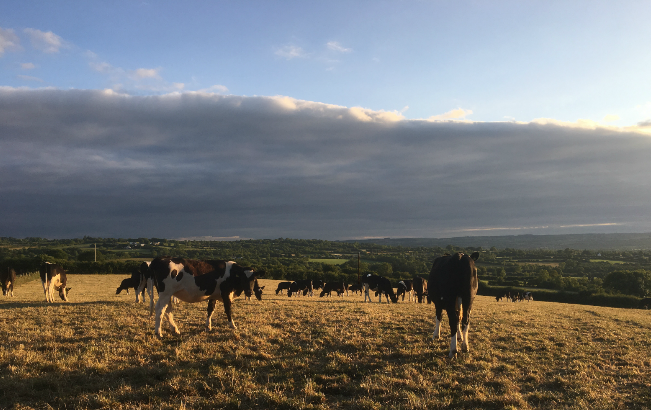
Dark clouds but no rain. The silver lining is the number of beautiful evenings we are getting at the moment but at the back of our minds is the knowledge that once the weather breaks, it might not stop raining for months. A feast or a famine this year!
Financial Cost
To be honest, we’re not counting up the financial cost as yet but to give you an example, we spent €4,500 on fertiliser for the silage ground. Slurry was also spread, some of which is still sitting baked on the ground. Add in the slurry spreading cost, the cost of making the bales and all we got was about 150 bales. Dairy nuts are arriving every ten days. Some of the calves are getting meal and silage.
We can’t do anything about the financial cost. The livestock still need feeding. All we can do is keep an eye on cashflow and concentrate on the health of the livestock.
Latest blog post: Farming in 2018 - from the frying pan to the fire Click To TweetCow Health
Despite the cows having plenty of water and feed, and being in fields with ample shade, a few have lost early pregnancies. It is relatively easy for a cow to lose a pregnancy up to day 50 in that stress can affect it. Cows can experience heat stress once it goes above 25C. The majority of the affected cows have been put to two bulls (to be sure, to be sure) while a couple will be culled at the end of this year. According to journalists in the Farming Independent this week, these losses are common at the moment. We’ve also noticed four amongst the 40 heifers which is quite a high percentage.
Otherwise, cow health is good. They are still milking well but it’s not an overly nice summer for them. We’re giving them the extra silage in the yard before milking so they are standing for longer. The grass isn’t tasty or lush. We had to treat them for flies again this week.
The yearlings (heifers and bullocks) are eating yellow crispy grass. They aren’t complaining as the grass is sweet but they aren’t thriving and growing as they normally would. Half of the calves are grazing what is left of second cut silage, the others are being supplemented with silage and meal. What could really be fun is when the rain comes and the bit of grass that is there becomes insipid and uninspiring and tasteless while we’re waiting for the fresh green grass to emerge from the soil. We’re desperate for rain but know that things could be worse for a few days in the short-term.
Compare to 1976
1976 seems to be the year that most refer to as the hottest in our memories. I was seven and carried containers of water to my sandpit where I made mudpies in my dolls tea sets. They set hard in the sunshine before I carved them up to share with my various invisible friends. I remember standing with my dad watching the last tractor draw out a trailer load of silage from the Big Field and we immediately opened the gates to let cattle in to eat the tall green grass that remained around the ditches. They came from the Banks field, the driest on the farm and once used for open cast mining. The wispy grass was yellow, large cracks evident in the parched ground and the cattle didn’t need to be asked twice to move.
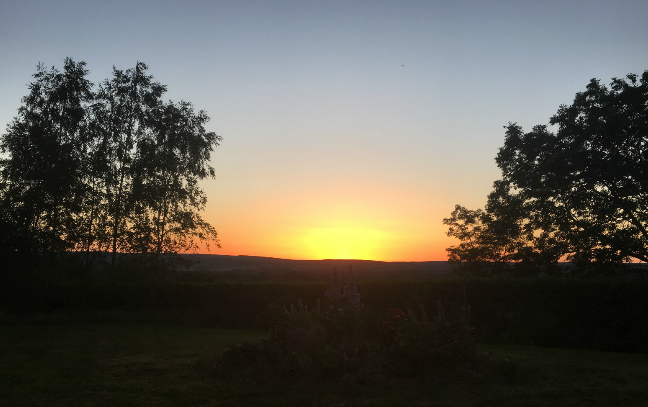
It’s taken forty years for a summer to be as hot but I think 2018 will be just that, we’ll be describing to our grandchildren as the year of two extremes.
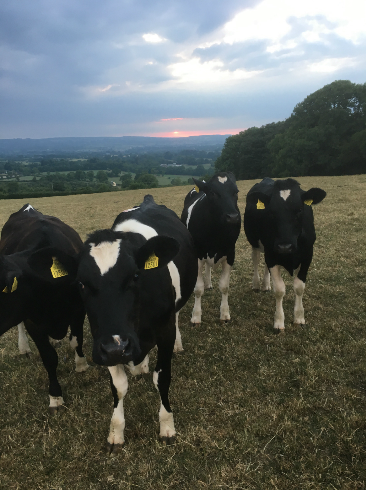
The heifers in High Shores, our driest field, and often a saviour as one of the only grazeable fields during wet weather
Some say that farmers are always pessimistic, even if they get good news they always seem convinced that doom is around the corner. I believe that farmers are eternal optimists, they pick themselves up after a bad year and believe the next one will be better. However, if circumstances are very favourable and they have an excellent year, they are never complacent. They know a toss of the dice by Mother Nature could change things drastically within weeks. The thing is even the most cheery and optimistic of farmers are really browned off now, it’s certainly a worrying time. I’d imagine the situation is affecting the mental health of many too. I see farmers on Twitter and Facebook offering each other support and advice. Australia farmers, obviously experienced with drought conditions, have been offering tips.
We have gone from one extreme to the other. As many have said, it has been the wettest, coldest, driest, warmest year, breaking many records. Could things be worse? Yes. Another wet summer where we’d struggle to find land dry enough to graze cows on and be wading around in muck would have been very tough psychologically. Give me dusty cow tracks over mucky ones any day. I suppose what is really getting on our nerves is the endless extra work and the difficulty to get some time off to enjoy the good weather . It’s proving really hard to even get a few hours off as when feeding fodder to cows, it takes time to collect the bales, push them in, being there to let them in early to eat before milking, even the feeding of meal to some calves who would normally be just on grass by now takes time each day and it all adds up. Big summer jobs such as spreading dung can’t be carried out yet as it would just bake in the sunshine and prevent grass growth whenever the rain does come. Farming was tedious in April and it’s getting tedious now too. Thankfully, we have got to the beach on a couple of occasions, even if only for a few hours. Even though we have plenty of open space and fresh air here, we needed a long walk by the water with sea air to blow away the cobwebs and rejuvenate our spirits and energy levels.

Is there a silver lining to all this? There always is one although sometimes it is hard to find. Lots of good quality hay has been made around the country. We are working in our shirt sleeves and shorts, enjoying the heat of the sun on our backs after a long cold winter. It will rain again, this is Ireland after all. As my dad said, maybe it will be a late winter and early spring. We’ll all be crossing our fingers.
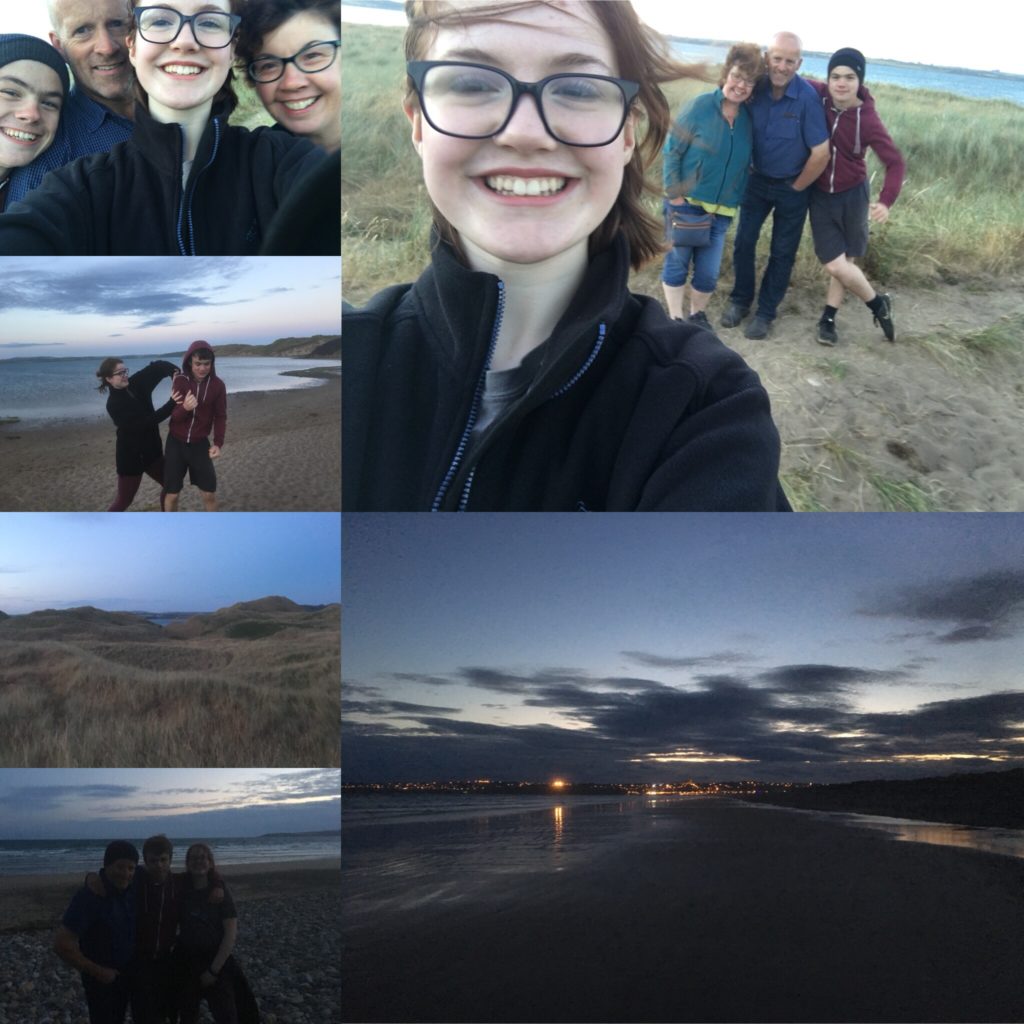
The question is will I be telling my grandchildren about 2018, describing it as a year of extremes, or will we see it become the new norm? April was our ‘frying pan’, July is our ‘fire’, fingers crossed rain comes soon.
The Cows Always Come Home
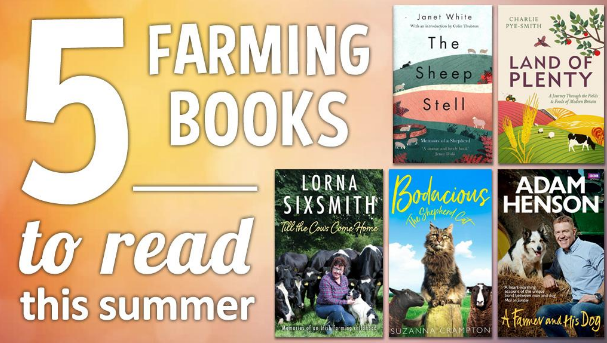 And if you would like to hear more about farming in our corner of Ireland, my memoir Till the Cows Come Home covers three generations of farming life. I was delighted that it was included in ‘Five summer farming reads’ in the Farmers Guardian this week. If you’d like the convenience of ordering it online but also want to support an independent bookshop, then do order it from Kennys – they ship worldwide for free. Also on Amazon of course 🙂
And if you would like to hear more about farming in our corner of Ireland, my memoir Till the Cows Come Home covers three generations of farming life. I was delighted that it was included in ‘Five summer farming reads’ in the Farmers Guardian this week. If you’d like the convenience of ordering it online but also want to support an independent bookshop, then do order it from Kennys – they ship worldwide for free. Also on Amazon of course 🙂






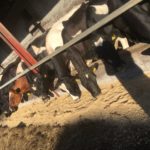

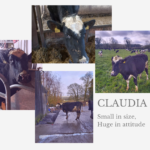
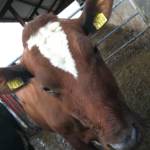
Emma lander
It’s a nightmare. Our fertiliser was a waste of money. It’s done nothing. We are worried we might not even get a second cut. Worrying times indeed
Lorna Post author
It’s getting late now for a good quality second cut but fingers crossed. It rained here this evening for about 90 minutes (proper rain for the first time in weeks) so hopefully growth will kick in soon. I see that the UK is to be very hot this week. It really is so serious now.